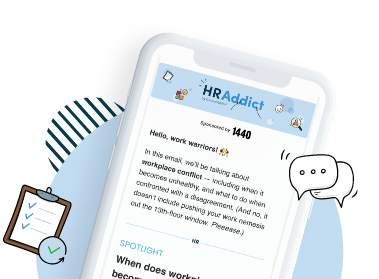Ending an employee’s contract, especially one who’s worked at your company for a while, is always difficult and, for better or worse, fraught with emotion — I can testify to this having conducted a few!
Whether it’s because the employee has resigned and is off to greener pastures or because you had to fire them, it’s vital to end the professional relationship on good terms – or at least as good as possible.
More often than not, however, employers neglect to conduct exit interviews that are actually useful. That’s unfortunate, as it’s one of the best ways to learn from your departing employees and it can lead to real improvements in your company, making it more likely that you’ll retain your top talent in the future.
The key to conducting an exit interview that is more than just an uncomfortable formality is to focus on:
- creating a neutral space that encourages the departing employee to speak openly and honestly
- keeping the answers confidential and anonymous
- being transparent with how you will use the information they provide
Here I’ll go over what exit interview best practices look like and what you should be careful to avoid when conducting them.
1. Time the Exit Interview Appropriately
The timing and frequency of exit interviews can end up making or breaking the quality of responses you receive.
While many employers tend to leave the interview for the employee’s last week, the Harvard Business Review notes that that might not be the best time to get the most out of the process.
If an employee has resigned, plan the interview for the mid-way point between when they gave their notice and their last day. That way, emotions will have cooled, but the employee will not yet have mentally exited the building. Any written references should be done prior to the exit interview being conducted.
Regarding how many exit interviews you should conduct, a good rule of thumb is to do one before the employee leaves and one after, leaving three to six months between the two meetings.
Use a different interview method for the second interview. The reasoning behind this is that people’s answers will change over time, and they might have more to add that hadn’t crossed their mind while they were in the thick of the offboarding process.
For exit interviews with employees whose contracts have been terminated, wait at least a month before conducting the interview, giving both parties enough time to reflect and have their emotions cool off a bit. This might mean that an in-person interview is not possible, however.
2. Select the Best Method for Your Company
There are plenty of ways to conduct an exit interview, and the jury’s still out on which is truly the best. Popular methods include face-to-face interviews, those conducted via video call or over the phone, as well as online questionnaires and written responses.
The right method will depend on your organisation, the amount of human capital the departing employee represents and budget considerations. Finding a method for your organisation and your employees that yields honest answers and a high participation rate will take some testing and trial-and-error.
When an employee’s departure calls for multiple exit interviews, the Harvard Business Review recommends using a combination of methods: generally, face-to-face interviews and another method to complement it.
Face-to-face interviews make it easier to read a person’s body language, meaning both parties are more likely to leave a good impression and avoid misunderstandings. Moreover, the more personal a discussion is, the more likely the departing employee will become a brand ambassador.
Face-to-face discussions also provide an opportunity for the employee to leave on the best terms possible. If a face-to-face interview is not possible, opt for a video call interview instead. If the departing employee is unwilling to take part in a face-to-face interview, a phone interview may be the best alternative, at least allowing for some back-and-forth and clarification if necessary.
At the same time, however, these discussions might not elicit the most candid responses from departing employees. That’s why it’s a good idea to supplement them with a standardised web survey or pencil and paper questionnaire. Although participation rates tend to be lower, these methods do allow for more frank responses. Plus, sometimes conducting face-to-face interviews (say, with dozens of temporary seasonal employees) isn’t worth the resources, making surveys a better alternative to the face-to-face methods mentioned above.
3. Choose the Interviewer
If you’re having immediate supervisors conduct exit interviews, you’re not going to get the most out of the process. Better alternatives include outsourcing the task, using HR or using non-immediate supervisors to conduct the interviews.
The benefits of outsourcing the process are that the individuals involved are trained in conducting exit interviews and will add an air of neutrality, meaning your departing employees are more likely to speak candidly. On the other hand, outsourcing exit interviews may give off the impression that no real action will come from the process.
A sort of middle ground is turning to your HR department to conduct exit interviews. However, if your HR department isn’t properly trained, they can end up impeding the process. Something else to consider is that someone from HR might actually be the reason why your employee is leaving. This may end with them skipping the exit interview altogether.
Then there’s the option of having higher-ups conduct the exit interviews. For top players, this is a good idea but, of course, not every leaving employee needs to meet with the CEO. Still, these meetings will at least let the departing employee know that their feedback will be acted upon, especially with regard to more structural issues.
Your organisation’s size, culture and resources will determine which is most appropriate. Alternatively - and this might be a bit radical - you could simply have the departing employee decide for themselves.
4. Use Standard Questions and Forms
Using a standardised interview questionnaire tailored to your company is essential for structuring the exit interview process well. By relying on forms, you won’t forget to cover a subject area, and you’ll be able to better compare answers over time and between employees.
Important topics to cover during an exit interview include:
- the good and the bad: what did the employee like and dislike about their time working at the company? Why have they decided to leave; why did they decide to stay?
- expectations vs reality: how did the job description align with the actual duties of the position? This is also where you might get valuable feedback on how to adjust the responsibilities listed in the job advert.
- chances for growth and advancement: how can your organisation foster a learning environment?
- company culture and work atmosphere: could they relate to the company’s core values and mission? Were they able to maintain a healthy work-life balance? (Questions concerning the social aspects of the job should make sure not to encourage the employee to gossip or rat on their coworkers, however.)
5. Maintain a Balanced Tone
Exit interviews are only successful when the departing employee feels comfortable enough to speak frankly and honestly about their experience working at your organisation. In other words, without trust, this essential feedback process is bound to fail.
Regardless of if the employee has been fired or they resigned, the interviewer should keep the discussion professional and courteous. The best way to do this is to really listen to the departing employee, making sure to let them speak and to not interrupt them.
Focus on creating an atmosphere that will allow for a relationship between the departing employee and the organisation to continue long after they’ve left. Not only should the departing employee hope to get a good reference from the employer, but the company should also hope the employee will recommend working for them to others.
6. Collect the Data (and Then Do Something with It)
Just because you’ve conducted exit interviews, it doesn’t mean they’re serving the purpose they should.
The qualitative data you gather in an interview should be collected and analysed. This makes it possible to detect any trends or structural problems. If, for example, you notice that many people from a certain department cite being micromanaged in their exit interviews, it might be worth looking into the managerial style of their supervisors and then providing any necessary training.
If the information never leaves HR, however, it’s unlikely that larger problems will be addressed. It’s, therefore, important for upper management to be informed, at least of the broader trends coming through in the exit interviews.
-
My advice to wrap things up: Don’t lose sight of the whole point of the exit interview. This is to gain insight into any issues HR has missed and to then improve your organisation for the employees that remain — and those that are soon to be hired. It's imperative to make full use of the exit interview.
Do you have anything you’d like to add or recommend? Leave a comment below.

